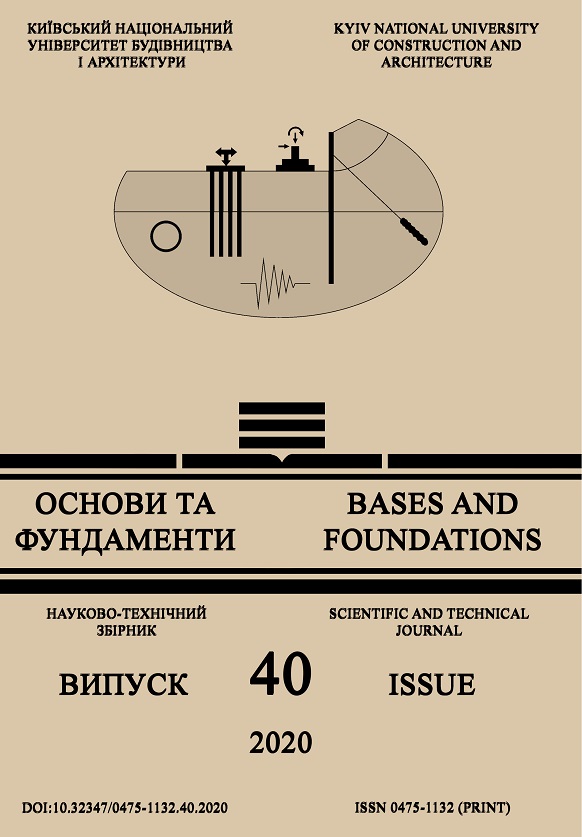Моделювання напружено-деформованого стану основи багатовиткової палі при її статичному навантаженні в пилувато-глинистому ґрунті
Основний зміст сторінки статті
Анотація
Проведено натурний експеримент з дослідження роботи багатовиткової палі при статичному вдавлюючому та висмикуючому навантаженні в пилувато-глинистому ґрунті.
Не зважаючи на ріст попиту на використання багатовиткових паль в сучасному будівництві, не існує жодного офіційного документу з розрахунку особливостей їх конструкції та несучої здатності.
Це викликає низку нових завдань перед інженерами та геотехніками: а) розробка нових сучасних методів розрахунку; б) розробка та використання сучасних нормативних документів та рекомендацій для розрахунку фундаментів з багатовиткових паль в різноманітних ґрунтових умовах; в) використання систем автоматизованого проектування для розрахунку складних геотехнічних задач; г) розробка розрахункових моделей, які будуть враховувати нелінійні моделі деформування матеріалів та ґрунтової основи. Фундаменти з багатовиткових паль є перспективним напрямком в галузі фундаментобудування за рахунок зменшення тривалості влаштування фундаменту а також його економічності. Для цього необхідна розробка нормативних документів з рекомендаціями для розрахунку та використання багатовиткових паль в галузі фундаментобудування, розробка сучасних розрахункових моделей для розрахунку несучої здатності та осідання багатовиткових паль в різних геологічних умовах.
На основі результатів проведеного натурного дослідження роботи багатовиткових паль в глинистих ґрунтах виконано числове моделювання напружено-деформованого стану основи багатовиткової палі, та порівняно їх результати.
Блок інформації про статтю

Ця робота ліцензується відповідно до Creative Commons Attribution 4.0 International License.
Автори, які публікуються у цьому журналі, погоджуються з наступними умовами: Автори залишають за собою право на авторство своєї роботи та передають журналу право першої публікації цієї роботи на умовах ліцензії Creative Commons Attribution License, котра дозволяє іншим особам вільно розповсюджувати опубліковану роботу з обов'язковим посиланням на авторів оригінальної роботи та першу публікацію роботи у цьому журналі. Автори мають право укладати самостійні додаткові угоди щодо неексклюзивного розповсюдження роботи у тому вигляді, в якому вона була опублікована цим журналом (наприклад, розміщувати роботу в електронному сховищі установи або публікувати у складі монографії), за умови збереження посилання на першу публікацію роботи у цьому журналі. Політика журналу дозволяє і заохочує розміщення авторами в мережі Інтернет (наприклад, у сховищах установ або на особистих веб-сайтах) рукопису роботи, як до подання цього рукопису до редакції, так і під час його редакційного опрацювання, оскільки це сприяє виникненню продуктивної наукової дискусії та позитивно позначається на оперативності та динаміці цитування опублікованої роботи (див. The Effect of Open Access).Посилання
V.L. Syedin, Yu.Yu. Volnianskyi, D.O. Makohonova (2019). Perspektyvy vy-korystannya fundamentiv z hvyntovykh ba-hatovytkovykh palʹ v budivnytstvi [Prospects for the use of foundations from screw multi-helix screw piles in construction]. Materialy pershoyi naukovo-praktychnoyi konfer-entsiyi studentiv DVNZ PDABA Materialy. – Dnipro : DVNZ PDABA, 45. (in Ukrainian).
Karpushyn S.O., Nevdakha A.Yu. (2010). Hvyntovi fundamentni pali [Screw founda-tion piles]. Naukovi zapysky: zb. nauk. pr. - Kirovohrad: KNTU, 10, 3, 191-194. (in Ukrainian).
Noskov I.V., Kazantsev V.G., Osipova M.A., Kozlova V.K., Merentsova G.S. (2013). Mnogolopastnyye vintovyye svai dlya stroitel'stva inzhenernykh sooruzheniy predpriyatiy pishchevoy promyshlennosti [Multi-blade screw piles for the construction of engineering structures for food industry enterprises]. Polzunovskiy Vestnik № 4-4. Barnaul: AGTU im. I.I. Polzunova, 258-262 (in Russian).
Knappett L., Brown M.J., Brennan A.J., Hamilton L. (2014). Optimizing the compressive behavior of screw piles in sand formarinere new able energy application. Proceedings of DFI/EFFC 11th international conference on piling and deep foundations.
Syedin V.L., Bikus K.M., Kovba V.V., Volnianskyi Yu.Yu. (2016). Modelyuvannya NDS osnovy bu-roin'yektsiynoyi pali ne z'yednanoyi z rostverkom, pry povtornykh statychnykh navantazhennyakh [Modeling of SSS of the base of a borehole injection pile not connected to a grid, at repeated static loadings]. Budivelʹni konstruktsiyi. Vyp. 83: Mekhanika gruntiv, heotekhnika ta fundamentobuduvannya: mizhvid. nauk. tekhn. zb. nauk. r. DP «Derzhavnyy naukovo-doslidnyy instytut budivelʹnykh konstruktsiy». Kyiv, 2, 236-243. (in Ukrainian).
Swolf W.M. [i dr.]. (2007). Rukovodstvo pol'zovatelya PLAXIS 3D Foundation [PLAXIS 3D Foundation User Guide]. Versiya 2 : per. s angl. / R.B.J. Brinkgreve, – Sankt-Peterburg: NIP-Informatika. (in Russian).
M. Hesahm El Naggar, F. Bagheri. (2015). Effects of installation disturbance on behavior of multi-helix piles in structured clays. DFI Journal The Journal of the Deep Foundations Institute . USA, 9 (2), 81-91
A. Sprince., L. Pakrastins. (2009). Helical pile behaviour analysis in different soils. Scientific Journal of Riga Technical University Construction Science. Latvia, №10 (10), 121-131.
Soltani-Jigheh, H., Zahedi, P. (2020). Load Transfer Mechanism of Screw Piles in Sandy Soils. Indian Geotechnical Journal. India, 50 (2).
